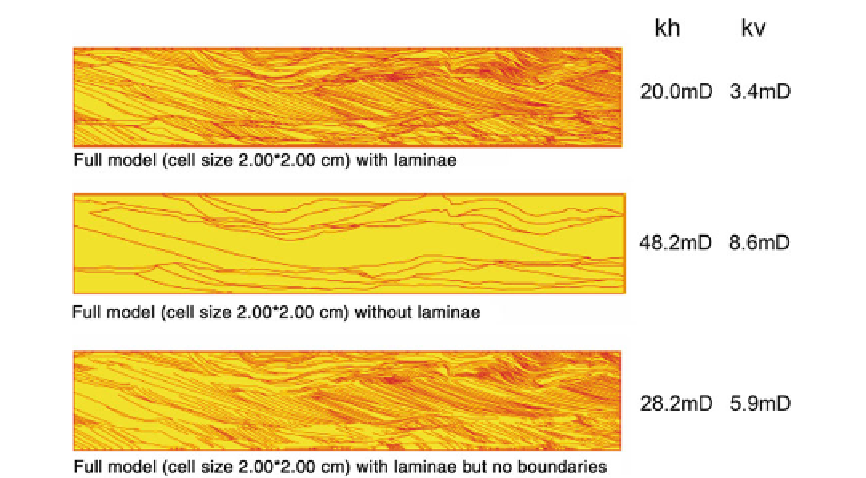Geoscience Reference
In-Depth Information
Fig. 6.6
Effective permeability in aeolian laminae.
Assuming: no-flow boundaries, 3 cm wind ripple laminae
(0.6 mD) and 60 mD grainflow bedsets; bounding surface
6 cm thick. (Pickup and Hern
2002
) (Redrawn from
Pickup and Hern
2002
, reproduced with kind permission
from Springer Science+Business Media B.V)
porosity on the metre-scale, which could be
calibrated against core plug data, and the orderly
k/
the more predictable form of the well-organised
aeolian bed sets. The effective properties of fine
scale heterogeneity have, for example, been
explored using small-scale models by Pickup
and Hern (
2002
), who show how the effective
permeability of an interval varies depending on
the presence or absence of laminae and the
baffling effect of bounding surfaces (Fig.
6.6
).
The effective permeability of small-scale aeo-
lian architecture can therefore usually be
quantified, and the main question for reservoir
modelling is how the REVs are architecturally
organised on a larger scale. This is less predict-
able and two principal
relationship from core plug data (e.g. Fig.
6.2
)
would lead to a reasonable estimate of the effective
permeability of the interval.
The wind ripple bed sets are more heteroge-
neous and a larger sample volume is required to
derive an effective average property. At the lam-
ina scale, permeability is highly variable. Cru-
cially, this occurs on a scale slightly smaller than
the core-plug, core plugs neither representing the
permeability of the coarse-grained laminae, nor
giving a representative average of good and poor
laminae. Log data will measure a reasonable
average porosity over both good and bad
laminae, but not necessarily the same average
as would be measured from core plugs. Put
another way, the scale of the measurement does
not coincide with the scale of the relevant REVs.
Small-scale modelling could be used to pro-
vide a better range of estimates of the effective
permeability as a function of scale for wind rip-
ple intervals.
Model-based handling of aeolian laminae is
comparable to the handling of thin bed
heterolithics (described in the tidal deltaic and
deep-water sections), the main difference being
˕
issues
recur when
modelling aeolian architecture:
1. How do the aeolian elements stack on a well-
spacing scale, and
2. Does the resulting pattern impart a large-scale
effective anisotropy on a producing reservoir?
6.1.3 Stacking
Strongly contrasting dune architectures are
reported for linear, barchan and star dunes, with
stacking patterns governed by the hierarchical
arrangement of bounding surfaces (e.g. Fig.
6.7
).

